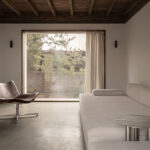
The introduction of the World’s Most Beautiful Museums List by the Prix Versailles underscores the importance of wonder in human experience, according to Gouadain. He noted that museums, by their very nature and purpose, significantly contribute to the goals of intelligent sustainable development. The recognition of these buildings, therefore, goes beyond aesthetics, highlighting their role in fostering sustainable and meaningful interactions between culture and the environment.
Here are the museums that have been selected for the 2024 list:

A4 Art Museum, Chengdu, China
Designed by Tektonn Architects, the A4 Art Museum is located in the Luxehills area of Chengdu. This museum stands out for its renovation of a hillside structure originally modeled after an 18th-century Tuscan town. The building’s division into three above-ground floors and two subterranean levels allows for impressive exhibition spaces while maintaining the picturesque charm of its surroundings.

Grand Egyptian Museum, Giza, Egypt
Heneghan Peng Architects are behind this architectural marvel which took 20 years to complete. Located near the Giza Plateau, the Grand Egyptian Museum offers visitors a breathtaking view of the iconic pyramids. The museum’s design incorporates ancient Egyptian principles, using light to enhance the visitor experience as they explore millennia of history.

Smritivan Earthquake Museum, Bhuj, India
This museum, designed by Rajeev Kathpalia, serves as a tribute to the resilience of the 12,932 victims of the 2001 Gujarat earthquake. The museum’s design integrates the natural landscape with a luxuriant forest and winding paths.

Simose Art Museum, Hiroshima, Japan
Pritzker Prize-winning architect Shigeru Ban designed this museum, which features eight mobile galleries with colored glass walls that light up at night. The Simose Art Museum’s innovative design, set against the backdrop of the Seto Inland Sea, creates a harmonious blend of physical and symbolic landscapes, celebrating the beauty of the region.

Paleis Het Loo, Apeldoorn, Netherlands
KAAN Architecten were tasked with extending this Baroque palace, originally built in 1686. The museum’s new underground extension, illuminated by natural light, reflects the historic hydraulic systems of the palace’s gardens. The design successfully balances old and new, making the grand foyer the heart of this elegant edifice.

Oman Across Ages Museum, Manah, Oman
Located near the Hajar Mountains, this museum was designed by Cox Architecture and draws on 800 million years of geological history. The museum’s towering spike and innovative design serve as a contemporary oasis in the desert, showcasing Omani culture and engineering in a setting that blends with its monumental surroundings.

Polish History Museum, Warsaw, Poland
Designed by WXCA, this museum is located in the Warsaw Citadel, part of one of Europe’s largest and most modern museum complexes. The building’s marble façades, arranged in horizontal strips, symbolize the layers of Polish history, offering visitors a tactile connection to the country’s past through its architecture.
As the anticipation builds towards the announcement of the World Titles later this year, the inclusion of these museums in the World’s Most Beautiful Museums List is a recognition of their ability to inspire, educate, and connect people across cultures. The Prix Versailles continues to celebrate architectural innovation and sustainability, with its World Selections for other categories, including Hotels, Restaurants, Emporiums, Airports, Campuses, Passenger Stations, and Sports, set to be announced between July and September.




wow! amazing list i have been to the one in Warsaw it is a stunning building